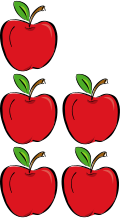- The operation or process of adding numbers together
- The result of adding numbers is called the Sum

Addition (usually signified by the plus symbol "+") is one of the four basic operations of arithmetic; the others are subtraction, multiplication and division. The addition of two whole numbers is the total amount of those values combined. An example is shown in the adjacent picture. There is a combination of three apples and two apples together, making a total of five apples. This observation is equivalent to the mathematical expression "3 + 2 = 5" i.e., "3 add 2 is equal to 5".
Besides counting items, addition can also be defined on other types of numbers, such as integers, real numbers and complex numbers. This is part of arithmetic, a branch of mathematics. In algebra, another area of mathematics, addition can be performed on abstract objects such as vectors and matrices.
Addition has several important properties. It is commutative, meaning that order does not matter, and it is associative, meaning that when one adds more than two numbers, the order in which addition is performed does not matter (see Summation). Repeated addition of 1 is the same as counting; addition of 0 does not change a number. Addition also obeys predictable rules concerning related operations such as subtraction and multiplication.
Performing addition is one of the simplest numerical tasks. Addition of very small numbers is accessible to toddlers; the most basic task, 1 + 1, can be performed by infants as young as five months and even some members of other animal species. In primary education, students are taught to add numbers in the decimal system, starting with single digits and progressively tackling more difficult problems. Mechanical aids range from the ancient abacus to the modern computer, where research on the most efficient implementations of addition continues to this day.
